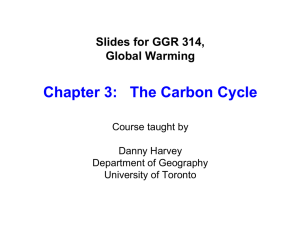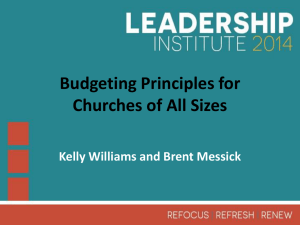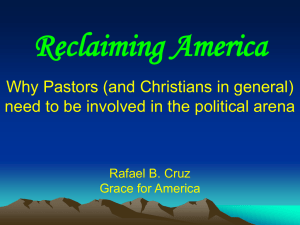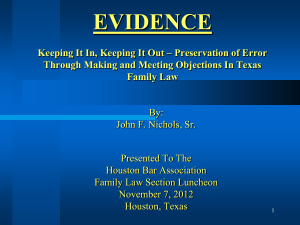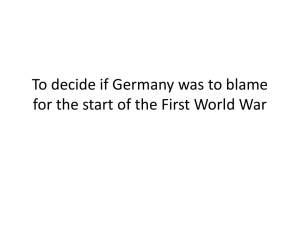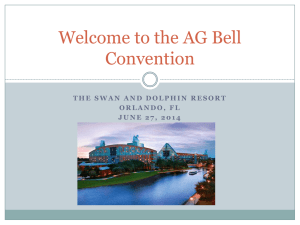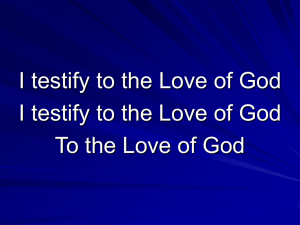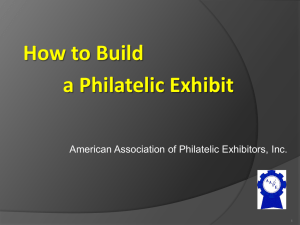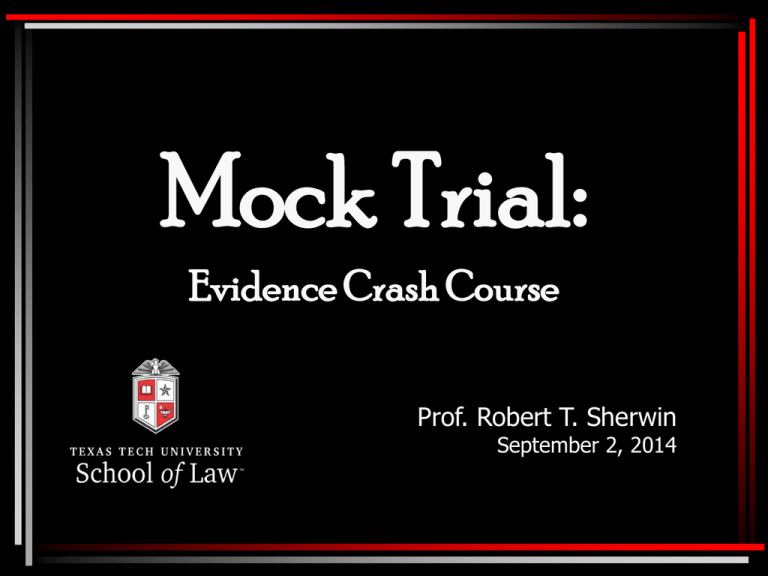
Mock Trial:
Evidence Crash Course
Prof. Robert T. Sherwin
September 2, 2014
1L Mock Trial
• For 1L Mock, the rules provided that all
evidentiary exhibits were pre-admitted.
• The rules also limited the types of
objections you could make.
• For Advanced Mock (fall and spring),
there are no limitations to objections,
and you need to establish the
admissibility of exhibits you want to
use.
2
Exhibits: The basics
• To be admitted into evidence, all
exhibits must be:
– Relevant (Rule 401)
– Authentic (Rule 901)
– Not otherwise inadmissible (substantially
more prejudicial than probative (Rule 403),
privileged, hearsay (Rule 802), character
evidence (Rules 404-07, 608-09, etc.))
3
Laying the foundation/authentication
• Rule 901:
– To satisfy the requirement of
authenticating or identifying an item of
evidence, the proponent must produce
evidence sufficient to support a finding that
the item is what the proponent claims it is.
• In other words, your witnesses need to
testify that the exhibits they’re
discussing are authentic and not fake.
4
Rule 901(b) and 902
• Rule 901(b) gives broad examples of
how to authenticate things like
handwriting, voices/telephone
conversations, etc.
• Rule 902 provides a list of 12 types of
exhibits that are “self authenticating.”
– Public documents, newspapers/periodicals,
trade inscriptions, checks/commercial
paper, etc.
5
Foundational checklists
• Laying the foundation is easy, albeit
formulistic.
• Consult Chapter 7 of Mauet’s “Trial
Techniques and Trials” book or the
Checklists and Foundations portion of
the “Courtroom Evidence Handbook” by
Goode and Wellborn.
6
Seven steps for admitting exhibits
①Mark the exhibit with a number (i.e.,
“Plaintiff’s Exhibit 3.”)
②Show opposing counsel exhibit.
③Show the witness the exhibit.
④Lay the foundation for admission.
⑤Move the exhibit into evidence.
⑥Discuss the exhibit with the witness.
⑦Publish the exhibit to the jury.
7
Example: tangible object
• Q: I’ve handed you what’s been marked
as State’s Exh. 1. Do you recognize it?
• A: Yes.
• Q: What is it?
• A: It’s my wallet that was stolen.
• Q: How do you recognize it?
• A: I remember what my wallet looked
like and it has my driver’s license and
credit cards inside just like I remember.
8
Example: tangible object (cont.)
• Q: Is Exhibit 1 in the same or
substantially the same condition today
as when you saw it last?
• A: Yes.
• “Your Honor, I offer State’s Exhibit 1
into evidence.”
9
Example: tangible object (cont.)
• Witness should testify that he/she:
– Recognizes the exhibit, and how he/she
recognizes it;
– Knew what it looked like on the day in
question, and how he/she knows; and
– Is certain the exhibit is in the same or
substantially the same condition as it was
when the witness last saw it.
10
Example: document
• Q: I’ve handed you what’s been marked
as Plaintiff’s Ex. 1. Do you recognize it?
• A: Yes.
• Q: What is it?
• A: It’s the contract I signed with Mr.
Jones in 2010.
• Q: How do you recognize it?
• A: I looked at it before I signed it, and
my signature is at the bottom.
11
Example: document (cont.)
• Q: Do you recall signing this document?
• A: I do.
• Q: Is this the original document or a
copy?
• A: A copy.
• Q: Is Exhibit 1 a true and correct copy
of the original contract?
• A: It is.
12
Example: document (cont.)
•
•
•
•
•
Q: Did the Defendant sign this contract?
A: Yes -- his signature is at the bottom.
Q: How do you know it’s his signature?
A: I saw him sign it.
Q: Is this contract in the same condition
as it was when you and he signed it?
• A: Yes.
• “Your Honor, I offer Plaintiff’s Exhibit 1
into evidence.”
13
Example: document (cont.)
• Witness should testify that he/she:
– Recognizes the exhibit, and how he/she
recognizes it;
– Knows whether it is an original or copy,
and if it’s a copy if it’s true and correct;
– Is certain the exhibit is in the same
condition as it was when the witness last
saw it; and
– [if the document contains a signature] can
verify whose signatures the document
contains.
14
Example: photograph
• Q: I’ve handed you what’s been marked
as Plaintiff’s Ex. 1. Do you recognize it?
• A: Yes.
• Q: What is it?
• A: It’s a picture of the accident scene.
• Q: How do you recognize it?
• A: I was there the day of the accident.
• Q: Did you take this picture?
• A: No.
15
Example: photograph (cont.)
• Q: Does this picture fairly and
accurately represent the accident scene
as you remember it?
• A: Yes.
• “Your Honor, I offer Plaintiff’s Exhibit 1
into evidence.”
16
Example: photograph (cont.)
• Witness should testify that he/she:
– Is familiar with the scene portrayed in the
picture;
– Is familiar with the scene at the relevant
date and time; and
– Is certain that the picture “fairly and
accurately” represents the scene as it
appeared on the relevant date.
17
Seven steps for admitting exhibits
①Mark the exhibit with a number (i.e.,
“Plaintiff’s Exhibit 3.”)
②Show opposing counsel exhibit.
③Show the witness the exhibit.
④Lay the foundation for admission.
⑤Move the exhibit into evidence.
⑥Discuss the exhibit with the witness.
⑦Publish the exhibit to the jury.
18
Exhibits for demonstrative purposes
• Sometimes, you can’t authenticate
something because it’s not the real
thing or isn’t a direct product of the
event in question.
• Examples: Models, diagrams, drawings,
mockups, computer simulations.
• If you’re only using the exhibit to
illustrate something to the jury, the
judge may allow it as a demonstrative.
19
Demonstrative foundation
• To use a demonstrative exhibit, you
only need to show:
– The exhibit relates to some piece of
admissible substantive proof and fairly and
accurately represents that proof; and
– The exhibit would aid the trier of fact in
understanding or evaluating the related
substantive evidence.
20
Example -- model
• Q: Mr. Smith, do you recognize Exhibit
6?
• A: I do.
• Q: How do you recognize it?
• A: It’s a model I created of the house.
• Q: Does this model accurately portray
and reflect the house?
• A: Yes.
21
Example – model (cont.)
• Q: Will this model assist you in helping
us understand your testimony about the
house?
• A: I think it will.
• “Your Honor, I offer Exhibit 6 for
demonstrative purposes.”
22
Final thoughts on authentication
• Think ahead of time what kinds of
things the witness needs to say to
authenticate an exhibit. Consult a
textbook or the Courtroom Evidence
Handbook for each type of exhibit.
• Script out your foundation questions.
• Don’t confuse authentication with
admissibility! Just because an exhibit is
authentic doesn’t mean it’s admissible!
23
Hearsay (insert scary music here)
• Merriam-Webster=“Rumor”
• Rule 801
– Hearsay means a statement that: (1) the
declarant does not make while testifying at
the current trial or hearing; and (2) a party
offers to prove the truth of the matter
asserted in the statement.
• Huh? What’s a statement? And who’s
this “declarant”? And what the $%&* is
“truth of the matter asserted”???
24
Statement and declarant
• Rule 801(a):
– “Statement” means a person’s oral
assertion, written assertion, or nonverbal
conduct, if the person intended it as an
assertion.
• Rule 801(b):
– “Declarant” means the person who made
the statement.
– The declarant is often (but not necessarily)
someone other than the witness.
25
Why we exclude hearsay
• When a witness on the stand is being
asked to testify about something someone
said or wrote out of court, we should be
concerned.
• Why? Because PEOPLE LIE when they’re
not under oath.
• We have to be concerned about out-ofcourt statements because they may have
been total BS when they were made.
• But we don’t exclude everything!
26
Some stuff gets in…
①Statements that aren’t offered “for the
truth of the matter asserted”
②Statements made by the opposing
party
③Some (but not all) of the testifying
witness’s out-of-court statements
④Docs w/ independent legal significance
⑤Statements that fall within a “hearsay
exception” (everybody sing along!!!)
27
The starting point…
• Is the witness being asked to testify
about an out-of-court statement
(EITHER his own statement OR
someone else’s)?
• If so, RED FLAGS! LOUD NOISES!
POSSIBLE HEARSAY!!!
• So, let’s calmly go through the analysis.
28
The analysis – Part 1
• First and foremost: Ask yourself why
you want the witness to testify about
what someone said out of court.
• For what purpose are you offering this
statement as evidence?
• Are you trying to prove the very fact
asserted in the statement? If so, you’ve
got problems (TOMA).
• But if not, IT’S NOT HEARSAY!!!
29
Truth of the matter asserted (TOMA)
• Example:
– P has sued D for running a red light and
causing a wreck. P calls Wally as a witness,
who will testify that he heard D’s wife say
“my husband ran the red light.”
– TOMA?
– YES!!! We care if this statement is true!
– P is trying to prove that D ran a red light.
The statement of declarant (D’s wife) is
being offered to prove that fact!
30
TOMA (cont.)
• Example:
– P has sued D for running a red light and
causing a wreck that killed P’s wife. D
admits he ran the red light, but says that
P’s wife died instantly and did not suffer. P
says his wife suffered in extreme pain for
two hours before dying. P calls Wally as a
witness, who will testify that he heard P’s
wife say “D ran the red light” one hour
after the accident.
31
TOMA (cont.)
• Example (cont.):
– TOMA?
– NO!!! We don’t care if the statement is
true; we’re not trying to prove whether D
ran the red light.
– P is only trying to prove that his wife was
alive by showing that she said something.
Whether what she said (“D ran the red
light”) is true is irrelevant – it could have
been a lie and we wouldn’t care.
32
TOMA (cont.)
• Example:
– In a murder case, the State calls Wally as a
witness, who says he heard Donna at a bar
say she saw D shoot the victim.
– TOMA?
– Yes!!! The State is trying to prove that D
shot the victim. Donna’s statement “I saw
D shoot the victim” tends to prove that
fact. Donna is free to take the stand and
testify herself, but Wally’s testimony about
what he heard Donna say is not OK!
33
TOMA (cont.)
• Example:
– In a murder case, the State calls Officer as
a witness, who says Wally called to say he
saw D burying a gun in the yard. The call
led Officer to find the murder weapon.
– TOMA?
– No!!! The State is trying to show the effect
of the statement on the listener (why and
how Officer found the gun). Wally’s
statement is only being offered to show
what led Officer to find the gun.
34
Some reasons other than TOMA
• To prove the declarant was capable of
speaking or his state of mind.
• To prove someone was warned or on
notice.
• To prove or explain the effect the
statement had on those who heard it
(i.e., why someone reacted the way he
did).
• Impeachment.
35
TOMA in sum
• Does the probative value of the
statement depend on its truthfulness?
• Otherwise put: Do we care if the
statement is true?
– If yes, then it’s being offered for TOMA.
– If no, then it’s not (and is not hearsay).
36
The analysis – Part 2
• If you determine that the statement is
being offered for the truth of the matter
asserted, ask, “is this the declarant my
opponent?”
• A declarant’s statement offered against
the declarant (who is now a party) is
non-hearsay (Rule (801(d)(2)).
• Whether true or false, the things you
say “can be held against you.”
37
Statements by party opponent
• Need not be an “admission.”
• Anything a party says out of court can
be used against that party and it’s not
hearsay.
• Example:
– State calls Wally to testify that D told Wally
“I bet it’d be fun to beat up Vicki.”
– D is the State’s party opponent, so the
State can use D’s statement (as testified to
by Wally) against him.
38
The analysis – Part 3
• Is the declarant also the witness? If so,
the statement is not hearsay if:
– It was made under oath in a different case
and is inconsistent with the witness’s
current testimony;
– It is consistent with the witness’s current
testimony and is being offered to rebut a
charge that the witness recently fabricated
his story; or
– It identifies a person as someone the
witness perceived earlier.
39
The analysis – Part 4
• Documents with independent legal
significance:
– Wills
– Contracts
– Checks
– Deeds
• They assert/establish legal rights,
responsibilities, and obligations. They
are NOT hearsay!
40
The analysis – Part 5
• If the statement:
– IS being offered for TOMA;
– Is NOT an statement by party opponent
(801(d)(2);
– Is NOT a prior non-hearsay statement by
the witness (801(d)(1); and
– Is not a document with independent legal
significance,
• Then: HEARSAY EXCEPTIONS!!!
41
Why have exceptions?
• The theory: Even though we’re not
under oath, sometimes we say things
under circumstances in which we
probably wouldn’t lie.
42
Rules 803 and 804
• Present sense impression (“we’re going really
fast!”)
• Excited utterance (“he’s got a gun!”)
• Then-existing mental, emotional, or physical
condition (“I’m scared!”)
• Statement made for medical diagnosis or
treatment (“This is the worst pain ever!”)
• Business records (timesheets, balance sheets)
• Dying declarations
• Statements against interest (“he sold me drugs”)
43
Final thoughts on hearsay
• Don’t forget the five-step analysis!
• Read and re-read 803 and 804 – create
(or find) a list of the exceptions that
you can quickly reference.
• Beware (but not afraid) of “hearsay
within hearsay” (Rule 805).
• Don’t fool around with the “residual
exception” (Rule 807).
44
Character evidence
• Rule 404(a):
– Evidence of a person’s character or
character trait is not admissible to prove
that on a particular occasion the person
acted in accordance with the character or
trait.
– In other words, you can’t offer evidence of
past crimes, wrongs, bad acts, or one’s
reputation in order to show that someone
acted in a particular way in your case.
45
Examples
• You can’t use evidence of one’s past
speeding tickets to prove he negligently
caused an accident.
• You can’t use evidence that someone
was convicted of robbery five years ago
to prove that he broke into your house
last week.
46
Exceptions
• In a criminal case:
– D can put on character evidence of
himself. That opens the door to the
prosecution to put on evidence to rebut the
D’s character evidence.
– D can put on character evidence of the
victim. Again, that opens the door.
– In a homicide case, the prosecutor may
offer evidence of victim’s peacefulness to
rebut evidence that the victim was the first
aggressor.
47
Exceptions
• In a civil case:
– Where character is an element of the claim
(defamation, negligent entrustment, etc.)
48
Permitted in all cases
• While you can’t use evidence of crimes,
wrongs, or other acts to prove that the
person acted in accordance with those
bad things, you CAN use them to show:
– Motive, knowledge, opportunity.
– Intent
– Absence of Mistake
– Identity
– Common plan or scheme
49
Methods of proving character
• If it is admissible (because D opens
door or under MIMIC), then you can
show one’s character by:
– Reputation or opinion
– Specific instances of conduct
• To show reputation, witness needs to
“lay foundation” by proving he/she is
familiar with the person, the relevant
community, and the person’s reputation
in that community.
50
Don’t forget about the rest of the 400s
• Habit: Rule 406
– Evidence of a person’s habit or
organization’s routine practice may be
admitted to prove that on a particular
occasion the person or organization acted
in accordance with the habit or routine
practice.
– It’s not really character evidence so much
as it is evidence of what someone always
or routinely does.
• Other rules
51
Character evidence and impeachment
• You can always impeach a witness with
evidence about his/her character for
truthfulness or bias.
• Methods:
– Opinion/reputation
– Specific acts that bear on honesty or bias.
– Convictions
• Crimes involving dishonesty
• Any felony
• But beware of “10 year” limit of 609(b)
52
Final thoughts on character evidence
• General rule: You can’t offer evidence
of prior bad things, a person’s bad/good
reputation, or another person’s opinion.
• Exceptions in criminal cases (D’s own
good reputation, which opens door) and
MIMIC.
• Find a way to make a MIMIC argument!
• You CAN use character evidence against
a witness for impeachment purposes.
53
Mock Trial:
Evidence Crash Course
Prof. Robert T. Sherwin
September 2, 2014

